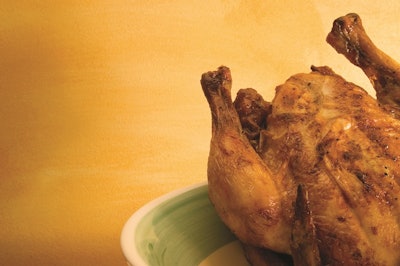
The chicken industry almost experienced a banner year, until prices fell sharply near the end of 2022.
Industry performance at a glance
According to WATT Global Media’s annual Top Broiler Companies survey, the top broiler companies produced about 1 billion pounds of ready-to-cook (RTC) chicken in 2022. That’s 16.38 million more pounds processed on a weekly basis than in 2021.
According to survey responses and industry research, 18 of the 31 companies included among the top broiler companies increased production between 2021 and 2022. Another eight companies saw production stay flat while five saw production fall.
“The U.S. poultry industry had a relatively strong year, but it was not easy,” Christine McCracken, executive director for animal protein at Rabobank’s RaboResearch Food & Agribusiness sector, said. “In broilers, many integrators posted record returns early in the year, but faced losses by year-end.”
From COVID to inflation
In 2020 and 2021, the chicken industry was deeply affected by the global and national COVID-19 health crisis. With an effective vaccine roll out in 2021, concern about the disease faded significantly by the end of 2022. For example, Tyson Foods Inc., the top processor in the U.S., dropped its mask requirement in February 2022 and then its vaccination mandate in November 2022.
However, the industry lurched from one crisis to another. As highly pathogenic avian influenza (HPAI) returned to the continent to shake up the turkey and egg industries, broad inflation began to affect the price of nearly everything in the U.S.
Consumers may have felt the pinch most at the grocery store. According to the U.S. Department of Agriculture Economic Research Service’s (USDA ERS) Food Price Outlook, shoppers paid 9.9% more for food in 2022. The same report estimates food prices will increase by another 7.1% in 2023. Prices increased by 3.5% in 2020 and 2021, too.
Price fluctuation
The integrated chicken industry saw what Mark Jordan, executive director of LEAP Market Analytics, called “phenomenally” strong demand, especially for wings and all boneless cuts of white and dark meat in the first half of 2022. McCracken said these high prices helped integrators offset record-high costs of production such as feed, labor and distribution.
However, by the end of the year, shoppers were fed up enough with inflation to reduce their discretionary spending, negatively impacting demand for chicken and other proteins which led to falling wholesale chicken prices. To further complicate matters, the industry finally shook off lingering breeder productivity issues which held back the supply of chicks for the past two years.
Looking ahead to 2023
Based on the negative trends at the close of 2022, as well as swelling, uncertain regulatory pressure coming from the USDA’s focus on modifying the Packers & Stockyards Act and the announced overhaul of Salmonella regulation, 2023 could be a hard year for the industry.
“It looks like 2023 will be at least unkind, and perhaps harsh, to the sector,” Jordan said. “Input costs are poised to remain extremely elevated, and industry stakeholders are now forced to navigate through much less favorable demand-side conditions.”
If there is a positive for the future, he said, it will be consumers heading back to affordable, healthy chicken during relatively hard economic times. This could boost the sector in 2023.
McCracken said Rabobank maintains a “relatively positive” outlook for poultry but recognizes challenges specific for the broiler industry. Chicken meat inventories will continue be burdensome early in 2023, but things may turn around by the end of the year.
“Slower production growth and a 4.5% decline in beef supplies will help the industry get back into balance, with exports also finding their footing on a more competitive U.S. dollar,” McCracken said.
Closing deals
The biggest chicken transaction in years was completed in 2022, creating a new, third-largest company: Wayne-Sanderson Farms.
In July 2022, the acquisition of Sanderson Farms Inc., formerly the third-largest integrated chicken company, by Cargill and Continental Grain Co. officially closed. The deal was announced in August 2021. The new company is led by Clint Rivers, formerly the CEO of Wayne Farms LLC.
Also in July 2022, the U.S. Department of Justice filed a civil suit against Cargill, Sanderson and Wayne Farms alleging various unfair practices up to and including collusion. In September 2022, the parties came to a settlement agreement. Sanderson Farms offered to pay a settlement of $38.3 million, while Wayne Farms agreed to pay $31.5 million and Cargill agreed to pay $15 million. None of the plaintiff companies admitted wrongdoing as part of the settlement.
In June 2022, Foster Farms, the largest poultry company on the West Coast, was acquired by private equity firm Atlas Holdings. The company is a major chicken and turkey producer. Atlas, which focuses on purchasing underperforming or discontinued operations and turning them around, appointed Donnie Smith to lead the company. Smith was CEO of Tyson Foods from 2009 to 2016.
Earlier in the year, in February 2022, JBS, the majority shareholder of Pilgrim’s Pride Corp., decided against acquiring the rest of the common stock of the second-largest integrated poultry company in the U.S. JBS currently owns more than 75% of the company.
Antibiotics use reduction
Continuing with the long-term trend, more companies in WATT Global Media’s top rankings are going antibiotic-free (ABF) or raising birds with no antibiotics ever (NAE).
According to the responses from the 2021 and 2022 survey, the following companies all raise 100% ABF or NAE birds:
- Allen Harim Foods
- Claxton Poultry Farms
- Farmers Pride Inc.
- Fieldale Farms
- Gerber’s Poultry
- Harrison Poultry Inc.
- Murray’s Chicken
- Shenandoah Valley Organic LLC
The following companies said they raise 25% or more of their flock NAE or ABF:
- Case Foods Inc. (33%)
- Foster Farms (36%)
- Miller Poultry (78%)
- Pilgrim’s (50%)
- Simmons (38%)
Amick Farms LLC, Peco Foods and House of Raeford Farms Inc. also indicated they are raising a portion of their flock ABF or NAE.
Expansion and renovation
After years of aggressive expansion, the chicken industry did not see as much construction and renovation as it had in the past three years. Nevertheless, major new processing facilities opened or were announced in 2022.
New facilities
- A new, $300 million, Tyson fully cooked products plant is expected to open in Danville, Virginia, in 2023.
- In 2022, Bell & Evans opened a new, $361 million organic processing plant and headquarters office in Fredericksburg, Pennsylvania.
- According to Koch Foods’ 2022 survey response, the company completed a new feed mill in Attalla, Alabama in 2022. In 2019, the Attalla project was valued at more than $50 million.
- In February 2023, the survey response said, Koch Foods will open a new further processing plant in Fairfield, Ohio, near an existing operation. Local media reports estimate the value of the Fairfield project to be about $220 million.
- In August 2022, Wayne-Sanderson Farms completed a $13 million hatchery expansion project in Dobson, North Carolina, which included gender sorting capabilities.
Notable improvements
- In its 2022 survey response, Mountaire said the company rebuilt sections of its Westover Feed Mill after it dealt with a major grain silo and dryer collapse in 2021.
- According to its 2022 survey response, Gerber’s Poultry added a controlled atmosphere stunning system and an additional kill line in 2022.
- In April 2022, Wayne Farms completed an expansion and upgrade of its prepared foods facility in Decatur, Alabama, which added a new cooked product line and a spiral freezer.
- In July 2022, Tyson completed a $90 million expansion to its poultry processing plant in Forest, Mississippi.
Announcements
- In January 2022, Simmons Foods Inc. announced plans for a $100 million expansion of its prepared foods operation in Van Buren, Arkansas. The expansion will create 100 new jobs and is expected to be complete in the first quarter of 2023.
- In April 2022, Tyson announced plans to spend $208 million to rebuild a rendering plant in Hanceville, Alabama, that was destroyed in a July 2021 fire.
- In July 2022, Pilgrim’s Pride Corp. said it was planning on increasing its production and expanding its facility in Athens, Georgia, as well as planning on building a new protein conversion plant for pet food ingredients in Georgia and a new prepared foods facility in the Southeastern U.S.
- In August 2022, Tyson broke ground on a $180 million expansion of a prepared foods facility in Caseyville, Illinois.
- In November 2022, Tyson announced a $18 million expansion of its hatchery in Walnut Grove, Mississippi.
4 chicken consumption predictions for 2030 WATTAgNet.com/45516









